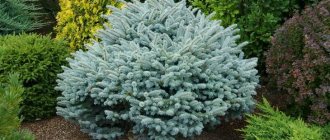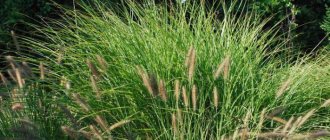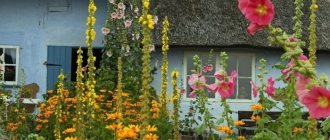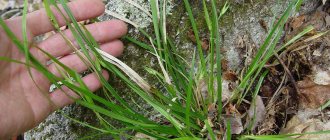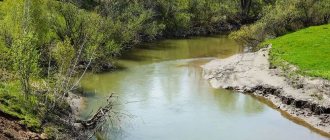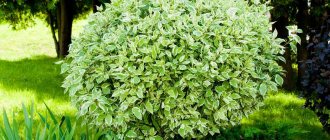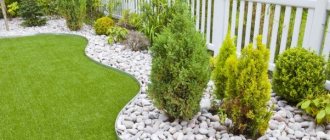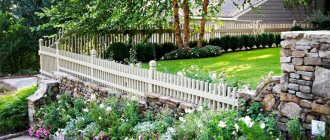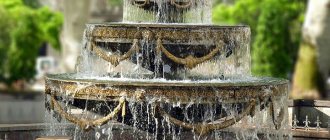Sometimes it seems that beautiful landscape design in the Moscow region is simply impossible - due to temperature changes, unpredictable weather and rather cold winters, beautiful plants do not seem to take root here. But don’t give up - there are many winter-hardy varieties and species that feel great even in central Russia. Since vertical gardening is rightfully considered the most spectacular, we’ll start with it - let’s look at frost-resistant vines for the Moscow region.
Maiden grapes
Let's start with the most simple perennial shrub vines.
There is nothing easier than growing virgin grapes. In the spring, cut lignified cuttings are planted in fertile, loose soil, watered regularly, supports are placed - and that’s it! After a couple of months, the rooted cuttings produce new shoots, which in a few years will completely cover the fence or wall of the house. Formative pruning needs to be done annually. This vine grows very quickly, climbing to great heights, but has an impressive mass, so the support must be strong. A very beautiful type of maiden grape - triacid - does not overwinter here, and the variegated form of the common one grows very slowly, so one cannot count on a quick effect.
Why is it the choice of climbing plants?
Decorating a garden with liana-like plants is beneficial, especially in small areas. Vertical gardening can significantly save usable space; plants are directed upwards and to the sides, while the root system can be located on a bed of less than a meter.
Besides:
- With the help of tall and low climbing specimens, you can successfully carry out zoning and create a cascade over the paths.
- Liana-like plants perfectly hide unsightly views, a slightly rusty neighbor's fence, an unsightly building or an ugly landscape behind the fence.
- Loaches provide oxygen and absorb carbon dioxide; this property is useful if tall trees cannot be planted in the garden.
- Lianas perfectly absorb dust, noise, and reduce the concentration of exhaust gases.
Plants can compete with profile, wooden or iron fencing. In some species (ivy, virgin grapes), the density of growth is so great that it creates an almost impenetrable curtain.
Schisandra chinensis
Among the most winter-hardy vines, we can mention Chinese lemongrass. It is not decorative enough in spring and summer. Although it blooms profusely, it has small white flowers with a delicate aroma. Only in autumn does lemongrass begin to be decorated with long clusters of bright red berries and yellowing foliage. Schisandra is also valued for its healing properties - it has a tonic effect, as well as for the lemon scent of leaves and berries that are added to tea. Schisandra prefers loose, moisture-absorbing soil in partial shade, with strong support. Under good conditions it reaches a height of 15 m. In the first years it grows slowly, expanding the root system. It is better to remove the shoots - this promotes more abundant flowering
4. Princes
Princes (clematis of the genus Atragene) bloom very well. The flowers, or rather the sepals, resemble bells in blue, white, purple, and cream colors. Even after flowering, they do not lose their decorative value, since original fruits appear, similar to dandelion parachutes. Unpretentious, can grow in both sun and partial shade. Many species of princelings overwinter with virtually no damage. They are attached to the support by leaves and petioles.
Princes
Honeysuckle Honeysuckle
Among perennial shrub vines, honeysuckle honeysuckle and other types of climbing honeysuckle stand out for their decorative value throughout the season. Quite large inflorescences of white, pink, crimson or yellow flowers, often in a variety of combinations, bloom magnificently in the first half of summer, and by autumn they are replaced by bright berries of red or orange color, like bright beads lying on green and saucer-like leaves! Honeysuckle honeysuckle is quite winter-hardy, but at a young age it is advisable to remove it from its support and cover it. Mature plants are left on supports. In severe winters they may freeze, but quickly recover and bloom on current shoots. The disadvantage of this type of vine is that over the years, if thickening branches are not cut off, the bush loses its beautiful shape, so it is necessary to annually cut out old or very small branches growing inward, leaving the most promising ones for growth. The remaining types of liana-shaped honeysuckle, although very beautiful, are not winter-hardy enough, require removal from the support and overwinter only with shelter.
Beautiful
Most flowering vines for the garden belong to this type. Almost all of them are afraid of severe frost and require covering them for the winter, or even better, removing them from the racks and putting them away.
The bases for such vines should be wooden: this allows them to be kept in the air longer in the fall and opened earlier in the spring, without fear of freezing. Among them:
- clematis;
- climbing roses;
- honeysuckle;
- wisteria;
- hydrangea.
Some beautiful vines, such as wisteria, entwine the stand very tightly and cannot be removed without damaging the plant itself or the base.
For these, you have to come up with special ways to protect yourself from frost. However, this type of vine is characterized by large, bright flowers and unusually shaped leaves, so most gardeners choose them.
Hydrangea petiolate
One of the very spectacular, although not winter-hardy, shrub vines is petiolate hydrangea. During mass flowering in mid-summer, its large inflorescences of many small fertile and large sterile white flowers envelop the vine like a cloud! At a young age, hydrangea grows very slowly. It prefers loose, moisture-absorbing loamy soil with an acidic reaction, like all hydrangeas. It is better to plant on the east or west side of buildings. For the winter in our climate, the vine must be removed from its support, trimmed for better tillering and covered with lutrasil. In the summer, every 2-3 weeks the soil is acidified with a special fertilizer for hydrangeas or conifers. For the winter, they are covered with peat or spruce litter.
Calistegia
Downy Calistegia (Calystegia pubescens), double form - as with hops, it is easier to start than to remove. The substantial white roots grow very actively, and in the spring a brush of shoots grows, entwining everything that comes nearby. Over the summer it rises 2-2.5 meters and covers part of the fence on the south side.
The best support for it is a grid of thin slats, a plastic mesh with large cells. At the dacha of friends I know, half of the chain-link fence is woven with calistegia: the mesh is not visible, and the plant does well, since it blooms very profusely in the open.
It blooms from mid-summer with large pink fragrant, slightly disheveled double flowers until frost. Faded flowers noticeably reduce their decorative value; you have to pluck them regularly. She doesn’t get sick, and no one eats her.
These are all the surviving beautiful flowering ones. Well, the roses are still climbing.
Fluffy calistegia (Calystegia pubescens), terry form. © allegro
Tree pliers round-leaved
Among other shrubby perennial lianas, I would like to note such a liana, which is still rare in our country - the tree plier. The most winter-hardy in our country is the round-leaved tree plier. This plant is made decorative by large clusters of bright orange or yellow boxes with scarlet berries inside that open in autumn. The fruits hang on the tree all winter, and all summer the shoots are densely covered with small oval leaves, which turn yellow by autumn. In winter, the ends of even this species freeze slightly; other types of wood pliers are even less winter-hardy.
What flowers grow in the shade of the house. Features of growing shade-tolerant plants
Shade-tolerant plants grow well in the shade, but still love bright light.
Unlike shade-loving plants, shade-tolerant plants love bright light, but in the process of their development they have learned to live in the shade. These flowers are excellent for office spaces and shaded rooms, and are also optimal for growing in the hallway.
These plants can withstand partial shade well without losing their decorative qualities. However, all shade-tolerant crops have varying degrees of sensitivity to shade, and some of them slow down their growth when they stay in shaded areas for a long time. For this reason, once every 1-2 months they must be temporarily moved to a bright room without direct sunlight.
Shade-tolerant plants must be placed at a distance of 2 m from the north window; in all other directions, the pots are 3 m away from the source of natural light. Plants grown in shady places often grow poorly and do not bloom, so decorative deciduous representatives of the flora are suitable for the farthest corners of the room.
Attention. Not a single plant, even the most shade-tolerant or shade-loving, can survive in places completely devoid of light.
Plant organisms need energy obtained through the process of photosynthesis, which, in turn, is impossible without light. Shade-tolerant plants require a light level of 1000 to 3000 lux, and a photo exposure meter or lux meter will help determine the light level.
There is a simpler method to find out whether indoor flowers have enough light. If a person with excellent eyesight can easily read an ordinary black and white newspaper, then this place is ideal for growing shade-tolerant plants.
Actinidia
Actinidia has recently become a very popular vine. This is a very powerful and fast-growing perennial vine with heart-shaped (in the Kolomikta species) or oval (in the Arguta or Polygam species with leaves, small but very delicate, and fragrant white drooping flowers, completely covering the shoots in the spring.
Recommended for you:
- Schisandra planting and care, growing Schisandra chinensis...
- Schisandra beneficial properties, use in folk medicine
- Lapageria photo, growing at home
- Grape growing, place for planting
Actinidia kolomikta is decorative throughout the season, but especially during flowering, when in addition to the flowers, the tips of the leaves turn white, then they turn pink and become crimson. Since this process is gradual, the vine has leaves of all shades, which looks very elegant. If your garden has both female and male plants, then after pollination a bonus to this beauty can be a harvest of very tasty berries, similar in taste to kiwi. The only drawback is the frequent freezing of flowers and leaves during return frosts, especially male flowers.
Actinidia will quickly recover, but there will be no fruit. Actinidia acuminata, or arguta, has larger, dark green foliage and male and female flowers on the same plant. This species has been living in my garden for more than 10 years, often freezes to the snow level, quickly recovers in the spring, almost does not suffer from return frosts, but has never bloomed. We simply use it as a very beautiful leafy vine. It was her male plants that were chosen by cats from all over the area. They rub their muzzles against the trunks and can seriously damage the plants, so it is better to fence them off somehow. Male actinidia acts as a tincture of valerian on cats.
For better fruiting in the fall, the vines are pruned quite heavily, cutting out the old branches. Pruning stimulates fruiting. You can't cut your hair in spring, because... juice will flow. Actinidia needs strong support because the vine is quite heavy. In the winter, the plants are mulched with organic matter, watered and fed in the spring.
The benefits of growing annual vines
Climbing annuals are increasingly being used in vertical gardening because they have a number of advantages:
- fast growth;
- easy propagation by sowing seeds;
- savings on purchasing perennial seedlings;
- many options for use in landscape design;
- large selection of species and varieties.
Annual climbing plants will never get boring; every year you can plant varieties with flowers of different shades and shapes, thereby renewing your garden landscape.
Requirement for sunlight
An important factor when choosing climbing annuals for the garden is the requirement for lighting. There are sun-loving and shade-tolerant crops, and there are much fewer of the latter; for example, morning glory belongs to them.
It is strictly not recommended to plant sun-loving climbing crops in the shade of trees and various buildings. If you do not heed this recommendation, you may never see them bloom.
Soil selection and preparation
Food crops are often found among climbing annuals. They are not recommended to be planted near walls, fences and other buildings, since the soil next to them may contain harmful chemicals that got there during painting or other construction work. On such soil, only decorative climbing annuals can be grown; however, before doing this, you will need to apply humus and complex mineral fertilizers.
As a rule, all climbing annuals need nutritious, loose soil that easily allows air and water to pass through. To make heavy soil looser, in addition to organic fertilizers, you can also add sand to it.
Neighborhood and compatibility with other plants
Another important step before planting is to evaluate the climbing annual's compatibility with other plants in the area. Crops that are susceptible to the same diseases and pests are not planted next to each other, otherwise, in the event of a disease, several plants can be lost at once.
When choosing neighbors for climbing annuals, it is necessary to take into account the structure of the root system. It is not desirable for it to be the same. So, if both plants located nearby have roots that grow to the sides, sooner or later they will intertwine with each other, thereby oppressing each other.
It is not recommended to plant plants that require the same nutrients nearby. In this case, the soil will quickly become depleted, which, in turn, will cause the plants to wither.
Important! Among climbing annuals there are also poisonous plants. Fruit and berry crops should not be placed next to them, since the poison they contain, along with fallen leaves, inflorescences or fruits, inevitably penetrates the soil.
Watering rules
As a rule, most climbing annuals are native to the tropics and subtropics, so they need plenty of watering. Watering rates depend on the type and variety of annual plant, time of year and weather conditions. The frequency of the event is on average 2 - 3 times a week.
Water climbing annuals in the morning or evening, when the main heat subsides and the bright sun disappears. Failure to follow these rules may result in foliage burns.
Installation of supports
There are two ways in which climbing annuals climb:
- attaching an annual plant to a support with tendrils (sweet peas, decorative beans);
- twining of climbing stems around a support (morning glory).
In the first case, the optimal support option is a soft mesh or wire. In the second there is a thin, rigid stand to which the shoots are tied.
When installing a support, it is important to consider that some types of climbing annuals can stretch to a height of up to 3 m, and sometimes more. Climbing annual flowers for the garden, planted in open areas, require the construction of a trellis, installation on strong posts of a metal mesh, tension of wire or twine. It is also widespread to use metal trellises, arches, pergolas and various buildings, including gazebos and terraces, as supports.
Kirkazon or Aristolochia
Among the woody vines there is a very spectacular and unusual plant - kirkazon, or aristolochia, with very large, sometimes up to 30 cm in diameter, heart-shaped leaves and flowers that look like a curved jug. This powerful plant, unfortunately, is not winter-hardy enough and requires removal from its support and shelter for the winter. The most frost-resistant species is Aristolochia Manchuria. In the Far East, where Kirkazon comes from, its shoots reach 15 m. In the middle zone, this vine winters well, but young plants must be covered. I would also like to mention such a rare liana as codonopsis with small oval pointed leaves and drooping blue or greenish-yellow bell-shaped flowers with a crimson limb. The plant is winter-hardy, but it is better to remove young plants from their support.
China latifolia
Latifolia is a member of the Legume family. It is sometimes confused with sweet pea, although it itself does not boast a strong aroma. However, chin is also called broadleaf pea.
This herbaceous plant can reach 4 m in length, clinging to the surface with tendrils. Chyna reproduces well by seeds, withstands frosts down to –29°C, and loves good lighting. The color scheme of large, showy chin flowers is white, pink, red-violet.
| Vine length (m) | Flowering time | Soil type | Peculiarities |
| 1,8-4 | June August | Sandy, sandy loam, loamy, limestone | Reacts poorly to transplantation in adulthood, best propagated by seeds |
Climbing and semi-climbing (rambler) roses
Climbing roses are remarkably beautiful, but very capricious. More often on sale there are semi-climbing, or rambler, with long, strong, non-climbing shoots that bloom once or repeatedly on last year's or current shoots. It is advisable to know all these characteristics about that variety. which you bought. Their winter hardiness varies greatly depending on the variety. Thus, the old variety Flammentanz, which blooms once with bright red flowers on last year’s shoots, is quite winter-hardy and has been blooming for me for many years. Many others gradually froze to death, some were eaten by mice in winter.
For the winter, the shoots of these roses are gradually bent and tied to a peg, the leaves are torn off, wrapped with a mosquito net from top to bottom so that mice do not eat them, and in late winter, when the temperature drops to minus 7 degrees, the base of the bush is covered with 2-3 buckets of loose compost soil. In the spring, they unplant the bush, but do not rush to lift it, because... Return frosts can severely damage green leaves. They are raised only when new shoots have already appeared on the plant. Old branches of three to four years of age are cut out almost to the base in the spring. The recently appeared Canadian climbing roses inspire us with cautious optimism; they are unlikely to winter much better. And they bloom very profusely all summer long.
We looked at shrubby perennial vines. Their advantages are very powerful growth, abundance of foliage and often beautiful flowering, but the disadvantage is the possibility of freezing in winter. Subshrubs and herbaceous perennial and annual vines do not have this disadvantage.
Hop
I can only conditionally classify common hops It is, of course, extremely durable (underground part). In a relatively short growing season it can grow numerous 5-meter canes, cover a significant area, bloom with fragrant flowers and bear very attractive and healthy fruits.
But with high air humidity, he suffers from fungal diseases. In addition, various pests that are decisively expelled from cultivated plants suck its juices and burst its leaves, despite their roughness: from spider mites, aphids and thrips to cutworms and sawflies. To harass them in this green mass - you won’t get enough poison.
That is, hops did not please me, but created a huge layer of problems, being a breeding ground for garden pests.
